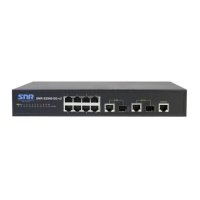SNR S2940-8G-v2 Switch Configuration Guide
Basic Switch Configuration
two points in the network. SNMP employs a polling mechanism of message query, and transmits
messages through UDP (a connectionless transport layer protocol). Therefore it is well supported
by the existing computer networks.
SNMP protocol employs a station-agent mode. There are two parts in this structure: NMS
(Network Management Station) and Agent. NMS is the workstation on which SNMP client program
is running. It is the core on the SNMP network management. Agent is the server software runs on
the devices which need to be managed. NMS manages all the managed objects through Agents.
The switch supports Agent function.
The communication between NMS and Agent functions in Client/Server mode by exchanging
standard messages. NMS sends request and the Agent responds. There are seven types of
SNMP message:
• Get-Request
• Get-Response
• Get-Next-Request
• Get-Bulk-Request
• Set-Request
• Trap
• Inform-Request
NMS sends queries to the Agent with Get-Request, Get-Next-Request, Get-Bulk-Request and
Set-Request messages; and the Agent, upon receiving the requests, replies with Get-Response
message. On some special situations, like network device ports are on Up/Down status or the net-
work topology changes, Agents can send Trap messages to NMS to inform the abnormal events.
Besides, NMS can also be set to alert to some abnormal events by enabling RMON function.
When alert events are triggered, Agents will send Trap messages or log the event according to
the settings. Inform-Request is mainly used for inter-NMS communication in the layered network
management.
USM ensures the transfer security by well-designed encryption and authentication. USM en-
crypts the messages according to the user typed password. This mechanism ensures that the
messages can't be viewed on transmission. And USM authentication ensures that the messages
can't be changed on transmission. USM employs DES-CBC cryptography. And HMAC-MD5 and
HMAC-SHA are used for authentication.
VACM is used to classify the user's access permission. It puts the users with the same access
permission in the same group. Users can't conduct the operation which is not authorized.
2.4.2 Introduction to MIB
The network management information accessed by NMS is well defined and organized in a Man-
agement Information Base (MIB). MIB is pre-defined information which can be accessed by net-
work management protocols. It is in layered and structured form. The pre-defined management
information can be obtained from monitored network devices. ISO ASN.1 defines a tree structure
for MID. Each MIB organizes all the available information with this tree structure. And each node
29

